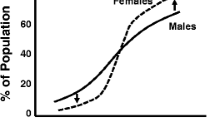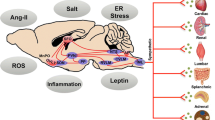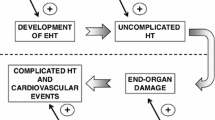Abstract
Normally, the kidney plays the dominant role in setting long-term arterial pressure, and the nervous system acts primarily as a short-term regulator, adjusting arterial pressure to acute challenges (eg, standing, running, and stress). However, in several animal models and in subsets of hypertensive human patients, the nervous system seems to play a more significant role in the chronic elevation of arterial pressure. Many clinical studies suggest that the peripheral sympathetic nerves are intimately involved in hypertension, and researchers recently characterized abnormalities in the brain that seem to predispose animal models to sympathetic nervous system overactivity and hypertension. Together, the current data strongly suggest that the brain, via the sympathetic nervous system, directly contributes to some forms of hypertension and indirectly contributes to all of them. This review is not intended as an exhaustive examination of all studies on the role of the nervous system in hypertension but rather focuses on several intriguing experiments that provide provocative new insights on this topic.
Similar content being viewed by others
References and Recommended Reading
FolkowB: Physiological aspects of primary hypertension. Physiol Rev 1982, 62:347–504.
EslerM: Sympathetic nervous system: contribution to human hypertension and related cardiovascular diseases. J Cardiovasc Pharmacol 1995, 26(suppl 2):S24-S28.
ManciaG: The sympathetic nervous system in hypertension. J Hypertens 1997, 15:1553–1565.
Calhoun DA, Mutinga ML: Race, family history of hypertension, and sympathetic response to cold pressor testing. Blood Press 1997, 6:209–213. This paper reports on the racial differences in sympathetic nerve activity responses to a stress.
Groppelli A, Giorgi DM, Omboni S, et al.: Persistent blood pressure increase induced by heavy smoking. J Hypertens 1992, 10:495–499.
Grassi G, Seravalle G, Cattaneo BM, et al.: Sympathetic activation in obese normotensive subjects. Hypertension 1995, 25:560–563.
Anderson EA, Hoffman RP, Balon TW, et al.: Hyperinsulinemia produces both sympathetic neural activation and vasodilation in normal humans. J Clin Invest 1991, 87:2246–2252.
Jamerson KA, Julius S, Gudbrandsson T, et al.: Reflex sympathetic activation induces acute insulin resistance in the human forearm. Hypertension 1993, 21:618–623.
Wyss JM, Oparil S, Sripairojthikoon W: Neuronal control of the kidney: contribution to hypertension. Can J Physiol Pharmacol 1992, 70:759–770.
Kopp UC, Smith LA, Dibona GF: Facilitatory role of efferent renal nerve activity on renal sensory receptors. Am J Physiol 1987, 253:F767-F777.
Dibona GF, Kopp UC: Neural control of renal function. Physiol Rev 1997, 77:75–197.
Coggan JS, Gruener R, Kruelen DL: Electrophysiological properties and cholinergic responses in guinea-pig celiac ganglion neurons in primary culture. J Auton Nerv Syst 1991, 34:147–155.
Supowit SC, Hallman DM, Zhao H, DiPette DJ: Alpha 2-adrenergic receptor activation inhibits calcitonin gene-related peptide expression in cultured dorsal root ganglia neurons. Brain Res 1998, 782:184–193. This study demonstrates that an adrenergic receptor can modify the release of CGRP from the distal ends of sensory neurons.
Oparil S, Chen YF, Berecek KH, et al.: The role of the central nervous system in hypertension. InHypertension: Pathophysiology, Diagnosis and Management,edn 2. Edited byLaraghJH, BrennerBM. New York:Raven Press; 1995:713–740.
Ito S, Sved AF: Tonic glutamate-mediated control of rostral ventrolateral medulla and sympathetic vasomotor tone. Am J Physiol 1997, 273:R487-R494.
KuboT: Cholinergic mechanism and blood pressure regulation in the central nervous system. Brain Res Bull 1998, 46:475–481.
Kubo T, Ishizuka T, Fukumori R, et al.: Enhanced release of acetylcholine in the rostral ventrolateral medulla of spontaneously hypertensive rats. Brain Res 1995, 686:1–9.
Ito S, Sved AF: Blockade of angiotensin receptors in rat rostral ventrolateral medulla removes excitatory vasomotor tone. Am J Physiol 1996, 270:R1317-R1323.
Averill DB, Tsuchihashi T, Khosla MC, Ferrario CM: Losartan, nonpeptide angiotensin II-type 1 (AT1) receptor antagonist, attenuates pressor and sympathoexcitatory responses evoked by angiotensin II and L-glutamate in rostral ventrolateral medulla. Brain Res 1994, 665:245–252.
Saigusa T, Iriki M, Arita J: Brain angiotensin II tonically modulates sympathetic baroreflex in rabbit ventrolateral medulla. Am J Physiol 1996, 271:H1015-H1021.
Ito S, Sved AF: Influence of GABA in the nucleus of the solitary tract on blood pressure in baroreceptor-denervated rats. Am J Physiol 1997, 273:R1657-R1662.
Averill DB, Matsumura K, Ganten D, Ferrario CM: Role of area postrema in transgene hypertension. Hypertension 1996, 27:591–597.
Collister JP, Osborn JW: The area postrema does not modulate the long-term salt sensitivity of arterial pressure. Am J Physiol 1998, 275:R1209-R1217.
Ernsberger P, Haxhiu MA: The I1-imidazoline-binding site is a functional receptor mediating vasodepression via the ventral medulla. Am J Physiol 1997, 273:R1572-R1579. This paper provides one of the most complete discussions available on the role of the central nervous system imidazoline system in arterial pressure control.
Ruggiero DA, Regunathan S, Wang H, et al.: Immunocytochemical localization of an imidazoline receptor protein in the central nervous system. Brain Res 1998, 780:270–293.
Reis DJ, Regunathan S: Agmatine: an endogenous ligand at imidazoline receptors may be a novel neurotransmitter in brain. J Auton Nerv Syst 1998, 72:80–85. The existence of the imidizoline receptor in the brain was supported by the discovery of an endogenous ligand.
Head GA, Chan CK, Godwin SJ: Central cardiovascular actions of agmatine, a putative clonidine-displacing substance, in conscious rabbits. Neurochem Int 1997, 30:37–45.
GuyenetPG: Is the hypotensive effect of clonidine and related drugs due to imidazoline binding sites? Am J Physiol 1997, 273:R1580-R1584.
Eglen RM, Hudson AL, Kendall DA, et al.: Seeing through a glass darkly: casting light on imidazoline “I” sites. Trends Pharmacol Sci 1998, 19:381–390. This article offers the most complete argument against the imidazoline hypothesis. Although it is one-sided, many of the criticisms presented need to be considered by proponents of the hypothesis.
MacMillan LB, Hein L, Smith MS, et al.: Central hypotensive effects of the alpha2a-adrenergic receptor subtype. Science 1996, 273:801–803. Using a single point mutation of the a2-adrenergic receptor, these authors show that the actions of the imidazoline agonists are dependent on central nervous system a2-receptors.
Morris ST, Reid JL: Moxonidine: a review. J Human Hypertens 1997, 11:629–635.
Prichard BN, Graham BR: The use of moxonidine in the treatment of hypertension. J Hypertens 1997, 15:S47-S55.
Head GA, Burke SL, Chan CK: Central imidazoline receptors and centrally acting anti-hypertensive agents. Clin Exp Hypertens 1997, 19:591–605. This article suggests that some of the disparity in the interpretation of central nervous system imidazoline receptors may be the result of an incomplete understanding of the neural circuitry in the brain. Specifically, they argue for the presence of an a2-receptor downstream from the I1 receptors in the medulla.
Eilam R, Malach R, Bergmann F, Segal M: Hypertension induced by hypothalamic transplantation from genetically hypertensive to normotensive rats. J Neurosci 1991, 11:401–411.
Brezenoff HE, Xiao YF: Acetylcholine in the posterior hypothalamic nucleus is involved in the elevated blood pressure in the spontaneously hypertensive rat. Life Sci 1989, 45:1163–1170.
Powis JE, Bains JS, Ferguson AV: Leptin depolarizes rat hypothalamic paraventricular nucleus neurons. Am J Physiol 1998, 274:R1468-R1472.
Shek EW, Brands MW, Hall JE: Chronic leptin infusion increases arterial pressure. Hypertension 1998, 31:409–414.
Wyss JM, Yang RH, Oparil S: Lesions of the anterior hypothalamic area increase arterial pressure in NaCl sensitive spontaneously hypertensive rats. J Auton Nerv Syst 1990, 31:21–29.
Peng N, Oparil S, Meng QC, Wyss JM: Atrial natriuretic peptide regulation of noradrenaline release in the anterior hypothalamic area of spontaneously hypertensive rats. J Clin Invest 1996, 98:2060–2065.
Peng N, Meng QC, Oparil S, Wyss JM: Acute saline infusion decreases norepinephrine release in the anterior hypothalamic area. Hypertension 1996, 27:578–583.
Budzikowski AS, Huang BS, Leenen FH: Brain “ouabain,” a neurosteroid, mediates sympathetic hyperactivity in salt-sensitive hypertension. Clin Exp Hypertens 1998, 20:119–140.
Bjorbaek C, Elmquist JK, Frantz JD, et al.: Identification of SOCS-3 as a potential mediator of central leptin resistance. Mol Cell 1998, 1:619–625. The use of SOCS-3 could be decisive in elucidating the inhibitory circuits in the brain that regulate arterial pressure.
Elias CF, Lee C, Kelly J, et al.: Leptin activates hypothalamic CART neurons projecting to the spinal cord. Neuron 1998, 21:1375–1385.
Elmquist JK, Ahima RS, Elias CF, et al.: Leptin activates distinct projections from the dorsomedial and ventromedial hypothalamic nuclei. Proc Natl Acad Sci USA 1998, 95:741–746.
Elmquist JK, Ahima RS, Elias CF, et al.: Leptin activates neurons in ventrobasal hypothalamus and brainstem. Endocrinology 1997, 138:839–842.
Zhang Z, Oppenheimer SM: Characterization, distribution and lateralization of baroreceptor-related neurons in the rat insular cortex. Brain Res 1997, 760:243–250. This study confirms that the cardiovascular control areas of the rat forebrain display lateralization.
Zhang ZH, Dougherty PM, Oppenheimer SM: Characterization of baroreceptor-related neurons in the monkey insular cortex. Brain Res 1998, 796:303–306. This is the first study to demonstrate lateralization of function in cardiovascular control nuclei in the primate cortex.
Oppenheimer SM, Kedem G, Martin WM: Left-insular cortex lesions perturb cardiac autonomic tone in humans. Clin Autonom Res 1996, 6:131–140.
Verberne AJ, Owens NC: Cortical modulation of the cardiovascular system. Prog Neurobiol 1998, 54:149–168.
Fisk GD, Wyss JM: Pressor and depressor sites are intermingled in the cingulate cortex of the rat. Brain Res 1997, 754:204–212.
Fisk GD, Wyss JM: Descending projections of infralimbic cortex mediate stimulation-evoked changes in arterial pressure. Brain Res 1999, in press. This study demonstrates that the lateral hypothalamic and midbrain sites mediate depressor responses to infralimbic stimulation.
Johnson AK, Thunhorst RL: The neuroendocrinology of thirst and salt appetite: visceral sensory signals and mechanisms of central integration. Front Neuroendocrinol 1997, 18:292–353.
Carlson SH, Osborn JW: Splanchnic and vagal denervation attenuate central Fos but not AVP responses to intragastric salt in rats. Am J Physiol 1998, 274:R1243-R1252. This study demonstrates that the hepatic sensory innervation regulates hypothalamic neuronal response to intragastric saline exposure in rats.
Johnson AK, Cunningham JT, Thunhorst RL: Integrative role of the lamina terminalis in the regulation of cardiovascular and body fluid homeostasis. Clin Exp Pharmacol Physiol 1996, 23:183–191.
Bourque CW, Oliet SH: Osmoreceptors in the central nervous system. Annu Rev Physiol 1997, 59:601–619.
Kovács KJ, Sawchenko PE: Mediation of osmoregulatory influences on neuroendocrine corticotropin-releasing factor expression by the ventral lamina terminalis. Proc Natl Acad Sci USA 1993, 90:7681–7685.
Peng N, Wei CC, Oparil S, Wyss JM: Role of the organum vasculosum of the lamina terminalis in NaCl-sensitive hypertension in spontaneously hypertensive rats [abstract]. Hypertension 1997, 30:109.
Richard D, Bourque CW: Atrial natriuretic peptide modulates synaptic transmission from osmoreceptor afferents to the supraoptic nucleus. J Neurosci 1996, 16:7526–7532.
Vatta M, Rodriguez-Fermepin M, Perazzo J, et al.: Atrial natriuretic factor enhances norepinephrine uptake in circumventricular organs, locus coeruleus and nucleus tractus solitarii of the rat. Neurosci Lett 1995, 197:29–32.
Wieldbo B, Sernia C, Gyurko R, Phillips MI: Antisense inhibition of hypertension in the spontaneously hypertensive rat. Hypertension 1995, 25:314–319.
PhillipsMI: Antisense inhibition and adeno-associated viral vector delivery for reducing hypertension. Hypertension 1997, 29:177–187. Although the potential of gene therapy in hypertension is only beginning to become clear, this paper shows that antisense techniques can facilitate the discovery of neural mechanisms underlying hypertension and potentially offer a useful therapy.
Phillips MI, Mohuczy-Dominiak D, Coffey M, et al.: Prolonged reduction of high blood pressure with an in vivo, nonpathogenic, adeno-associated viral vector delivery of AT1-R mRNA antisense. Hypertension 1997, 29:374–380. This paper demonstrates the long-term effects of antisense therapy in the rat.
Martens JR, Reaves PY, Lu D, et al.: Prevention of renovascular and cardiac pathophysiological changes in hypertension by angiotensin II type 1 receptor antisense gene therapy. Proc Natl Acad Sci USA 1998, 95:2664–2669. This paper shows that systemic retroviral therapy can mimic the effects of antisense delivery into the brain.
Author information
Authors and Affiliations
Rights and permissions
About this article
Cite this article
Wyss, J.M., Carlson, S.H. The role of the central nervous system in hypertension. Current Science Inc 1, 246–253 (1999). https://doi.org/10.1007/s11906-999-0029-2
Issue Date:
DOI: https://doi.org/10.1007/s11906-999-0029-2




